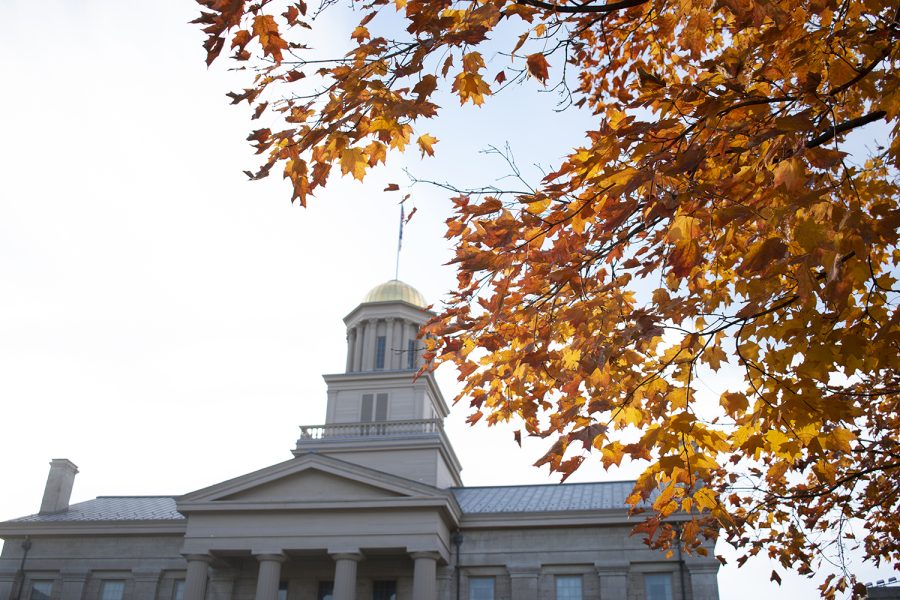Iowa City, University of Iowa diversify tree canopy to changing weather
Iowa City Parks and Forestry and University of Iowa campus arborists are planting different species of trees to diversify Iowa City’s trees during changing weather.
A maple tree is seen in front of the Old Capitol on Monday, Nov. 8, 2021.
November 9, 2021
New trees planted around the University of Iowa and Iowa City have diversified the local tree population as caretakers fight to fend off cold weather and other developing challenges, like invasive species, that harm trees.
Iowa’s cold weather, drought, and flooding have affected the “hardiness zones,” meaning the type of tree that would have been planted 30 years ago would not be planted now, UI arborist Andy Dahl said.
Dahl said droughts in Iowa can impact the amount of fall coloring trees have.
“So years that are super dry, sometimes the trees will just go dormant early and you won’t get much color at all,” Dahl said. “They just fall off green.”
Cold weather affects how soon trees drop their leaves, Dahl said.
“I didn’t think it was a particularly good year last year because we had snow around Halloween, so our tree’s leaves kind of fell off without much color,” Dahl said.
This year, Iowa has not experienced the cold weather to cause the leaves to drop, he said.
Dahl said his team has planted more cold-climate trees as the weather fluctuates from past years, in hopes of a healthier population.
“We have southern magnolia, sourwood, sweetgum, we even have torreya — species that 30 years ago we probably wouldn’t have tried, but now we’ve got some that have been around for a decade or more,” he said.
Dahl said his team of four plants the trees around campus every year, and takes care of about 8,000 trees on campus.
“We usually plant three to four hundred [annually],” he said.
Tyler Baird, superintendent of parks and forestry for Iowa City, said the type of species the city plants is always shifting.
“We’re trying a lot of different trees as climate changes or climate fluctuates,” Baird said. “Things that may not appear on here before that might grow in the future and vice versa, things that maybe we’re just on the edge of growing mold in our climate that may not anymore.”
This year, Baird said the city has planted three times the number of trees it typically would.
“We were averaging around 400 new trees a year,” he said. “And this year, there’s a few less to be planted on a contract that a contractor is doing, but once that’s finished up, we will be around 1,200 this year.”
Baird said there are three main factors driving the increase in tree planting.
“We’re trying to increase our tree canopy to meet our climate action goal, but also we are losing a lot of trees with the emerald ash borer and the infestation of our ash trees with that borer,” he said. “And then we also lost some trees during the derecho. So we’re working to get some canopy back.”
Dahl said the university plants trees from local and national vendors, in addition to growing their own.
“We grow a lot of our own in our greenhouse and nursery,” he said. “We’ll collect seeds from various trees — whether it’s an oak tree that is dropping acorns or we take something else — we will grow those out and plant them on campus.”
Dahl said he plants trees consistently throughout the year.
“I plant trees every month, except February, here on campus,” he said.
Dahl said of the 8,000 trees on campus, there are around 330 different species.
Most trees are brought in during the spring because there is more of a selection than in the fall, Dahl said.
In the fall the trees have already been picked over, Dahl added, so he chooses from the remaining species.
“Usually I want the unusual, weird stuff, which is what’s leftover,” he said.



